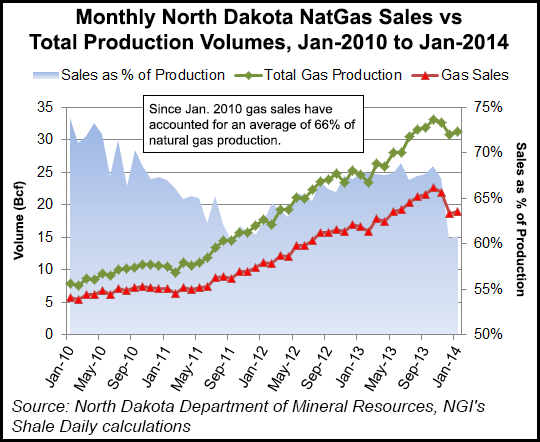Shale Daily | Bakken Shale | E&P | NGI All News Access
Unsold Bakken Gas Spiked in 2013, But Relief Is Coming
With North Dakota’s robust Bakken Shale oil and associated natural gas production growth last year, the volumes of unsold gas shot up considerably, averaging 310 MMcf/d, according to the latest data from the U.S. Energy Information Administration (EIA). State and industry officials, however, said Monday the upward trend is about to be reversed.

The EIA statistics that show a jump from an average of 160 MMcf/d in 2011 for unsold gas to the 310 MMcf/d last year reflect earlier North Dakota state statistics showing flaring back at a record-setting 36% for December and January (see Shale Daily, March 5).
Relief from the high flaring numbers is coming, starting later this week, according to officials with the North Dakota Petroleum Council (NDPC) and the Department of Mineral Resources (DMR), with the start up of additional gas processing capacity and the implementation of new oil/gas drilling rules.
“There was an increase in the amount of gas flared in the last few months, and that is primarily because the [Hess Corp.] gas plant near Tioga was shut down for an expansion and then also because of the cold weather we’ve seen,” NDPC spokesperson Tessa Sandstrom told NGI‘s Shale Daily. “[Tioga is] starting that back up this week, so we are expecting the percentage of flared gas to drop.”
A DMR spokesperson said the state oil/gas regulator is “eagerly awaiting” the reopening of the Tioga gas plant “to see the impact this increased capacity will have on reducing flaring.”
DMR intends to implement a newly adopted flaring reduction policy (see Shale Daily, March 14), beginning with an upcoming April 22 hearing “to address possible production restrictions or any other methods necessary to reduce flaring,” said DMR’s Alison Ritter.
Rapid increases in production in recent years have “outpaced additions to the state’s gas pipeline capacity and processing facilities,” said EIA’s latest bulletin and earlier reports from state officials. “As a result, the amount of non-marketed natural gas [including all flared gas] continued to grow through the end of 2013, rising to an average of 310 MMcf/d, almost double the 160 MMcf/d levels in 2011,” said EIA, using state DMR-originated statistics.
© 2024 Natural Gas Intelligence. All rights reserved.
ISSN © 2577-9877 | ISSN © 2158-8023 |
